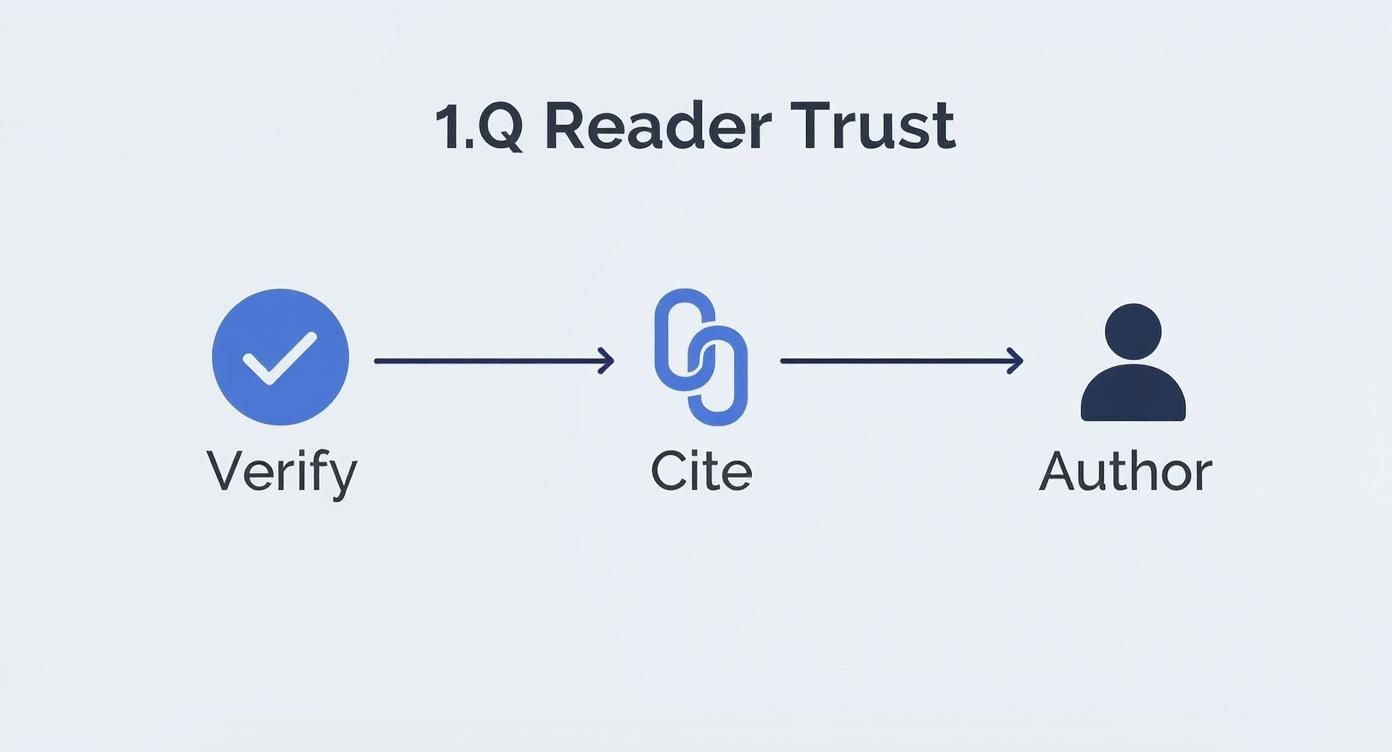How to Humanize AI Content That Truly Connects

To really make AI content feel human, you have to add your own personality, stories, and voice into the first draft. This is the step that turns robotic, generic text into something that actually builds real trust and connection with your readers.
Why Making AI Content More Human Is Essential
In a digital world flooded with machine-written text, just hitting "publish" on raw AI output is a recipe for being ignored. Let's be honest—readers and search engines are getting tired of the same old soulless information that lacks any real point of view. The internet is quickly becoming a giant echo chamber, and your audience is looking for a voice, not just information.
Adding a human touch isn't just a nice-to-have anymore; it's the only way to capture and hold someone's attention. This is where you stop being just a content producer and start being a trusted guide for your audience.
The Growing Need for Authenticity
Before jumping into the 'how,' it helps to understand the fundamentals of AI content writing to see why this personal touch is so important. It’s all about closing the gap between what a program can produce and what a person actually wants to read.
The predictions are pretty wild. By 2025, it's expected that over 60% of all online content will be AI-assisted in some way, which means an absolute mountain of new material. This explosion has also let loose a wave of generic writing that just doesn't connect with people emotionally.
This lack of authenticity hurts key measurements like bounce rates and conversions. Even search engines are updating their guidelines to penalize low-effort content that feels like it was written by a machine.
Making content feel human is less about technical editing and more about forming a real connection with your reader. It's the difference between a textbook and a conversation with a trusted expert.
This whole shift means your unique perspective, personal stories, and distinct personality are your biggest assets. These are the things machines can't copy, and they're what will make your content memorable.
For those looking to make this work easier, a dedicated paraphrasing tool like Word Spinner can be a great help. Its advanced rewriting helps remove those repetitive AI patterns and adjust the tone for a more natural feel, all while giving you 100% plagiarism-free output.
AI Text vs. Human-Touched Content: A Quick Comparison
To really see what a difference this makes, it helps to put the two side-by-side. The goal is to move from text that simply exists to content that draws people in, persuades them, and builds loyalty. You can also dive deeper into why humanizing AI content is essential for engagement in our detailed guide.
Here’s a quick look at the core differences between a standard AI draft and a piece of content that's been properly humanized.
| Characteristic | Standard AI Content | Human-Touched Content |
|---|---|---|
| Tone of Voice | Often formal, neutral, or inconsistent. | Consistent, authentic, and reflects a unique personality. |
| Storytelling | Lacks personal anecdotes or relatable examples. | Weaves in real stories and experiences to illustrate points. |
| Originality | Can produce generic ideas and common phrases. | Offers unique insights, opinions, and a fresh perspective. |
| Emotional Connection | Fails to stir emotion or build rapport. | Creates a strong connection by showing empathy and understanding. |
| Credibility | Presents facts without context or authority. | Builds trust through expertise, cited sources, and a clear viewpoint. |
The takeaway is simple. Making your content more human isn't just some extra step; it's the main event. It’s how you prove that a real, knowledgeable person is behind the words, ready to help the reader solve their problem.
Setting the Stage for Better AI Drafts
https://www.youtube.com/embed/P08jrZhyNxw
The secret to a much easier editing job starts long before you even produce the first word. If you want to humanize AI content, you need to stop thinking of the AI as a writer and start treating it like a brilliant but very literal assistant.
A vague request gets you a vague, robotic draft. But a detailed, specific brief? That gets you a first pass that's already halfway to the finish line.
Supplying this context upfront is the single most powerful thing you can do to save yourself time and frustration later. It’s the difference between getting a generic block of text and a draft that already has a spark of personality and a clear direction.
Defining Your Ideal Reader
Before you can write for someone, you need to know who they are. AI tools are fantastic at taking on a persona, but you have to give them one first. Just telling the AI to write for "marketers" is a recipe for bland, generic content. You have to get more specific.
Consider these details to paint a clear picture for your AI assistant:
- Experience Level: Are they a total beginner looking for first steps, or a seasoned pro who needs deep, nuanced insights?
- Pain Points: What specific problem are they trying to solve right now? What's the thing that's keeping them up at night?
- Goals: What do they hope to walk away with after reading your content? A quick answer, a new skill, a deep understanding?
For example, instead of a lazy prompt like, "Write for small business owners," try this: "Write for a brand-new small business owner who is completely overwhelmed by marketing. They need simple, low-cost ways to find their first 10 customers." That level of detail immediately shapes the language, examples, and complexity of the draft you get back.
Giving your AI a clear audience profile is like giving a GPS a destination address instead of just a city name. You get a much more direct and useful route.
Setting a Specific Tone of Voice
Tone is where the human element truly comes to life. An AI’s default voice is often neutral, formal, and, let's be honest, pretty boring. To get a draft that sounds like a real person wrote it, you have to command a specific voice from the very beginning.
Don't just use one-word commands like "friendly" or "professional." That’s not enough. You need to combine adjectives and add context to create a more nuanced, believable voice.
Examples of Strong Tone Prompts:
- Witty and informal: "Write like a clever friend sharing a secret over coffee. Use a bit of humor and keep the sentences short and punchy."
- Empathetic and reassuring: "Adopt a calm, supportive tone, like a trusted mentor guiding someone through a difficult problem. Make sure to acknowledge their frustrations."
- Authoritative but approachable: "Write with the confidence of an expert, but break down complex ideas with simple, everyday analogies. Avoid jargon at all costs."
By clearly defining the tone, you're telling the AI which words to pick, how to structure its sentences, and even what kind of rhythm to aim for—mirroring how a person with that personality would actually speak. This simple step is a cornerstone of an effective content creation workflow and helps you get natural-sounding text right from the start.
Give It Some Personality and Real-World Grit
This is where the real fun begins. Your AI draft is the clean, well-structured skeleton. Now, you get to add the flesh and blood—the stuff that makes your content uniquely yours.
An AI can spit out facts and assemble sentences, but it has no lived experience. This next part is all about putting your voice, your stories, and your hard-won opinions into the text. It’s how you go from just informing your audience to actually connecting with them.
Swap Robotic Phrases for Your Own Voice
First things first: AI language can feel a bit… stiff. Since it learns from a massive, generic collection of information, it tends to use formal, overused phrases. The quickest fix is to read through the draft and replace anything that sounds like a robot wearing a suit.
Ask yourself, "How would I say this to a colleague over coffee?" Then, just write that down instead.
-
Instead of: "It is imperative to consider…"
-
Try: "You absolutely have to think about…"
-
Instead of: "This methodology yields positive outcomes."
-
Try: "This approach just flat-out works."
This isn't about dumbing it down. It's about being direct and conversational. This one simple tweak immediately makes your content feel more approachable and authentic.
Weave in Personal Stories and Examples
We’ve all heard it: facts tell, but stories sell. It’s a cliché for a reason. Wrapping a key point in a real-world story is the fastest way to build trust and make an idea stick.
An AI can give you a generic example, but it can’t tell the story of that one time you completely botched a project and what you learned from it. Those moments are content gold.
Look at the main arguments in your article and dig into your own experiences:
- Have I personally struggled with this? What happened?
- Do I know a client who navigated this exact problem?
- What’s a specific mistake I made that relates to this topic?
Sharing those moments—the wins, the failures, the "aha!" insights—is incredibly powerful. It proves you’re not just repeating what you read online; you’ve actually been in the trenches. It’s the essence of how to show and not tell when writing, turning dry advice into something your reader can actually feel.
When you share a personal story, you're giving the reader a reason to care. You're turning a sterile piece of information into a shared human experience.
This kind of authenticity is exactly what people are looking for. Despite the flood of AI-produced articles, truly human content still sees engagement rates as much as 47% higher. People connect with the nuanced opinions and personal stories that only a real person can share.
Don't Be Afraid to Share Your Opinion
Here’s the thing: your unique perspective is your biggest advantage. AI models are built to be neutral, balanced, and frankly, a bit boring. You aren't. You have opinions, beliefs, and a point of view shaped by years of experience.
Use it.
- Do you disagree with a popular piece of advice in your industry? Say so, and explain why.
- Have a controversial take on a new trend? Lay out your argument.
- Is there one tool or technique you swear by? Tell people why it’s the best.
Putting in your honest opinions is what makes your content stand out from the endless sea of sameness. It signals to your audience that a real, thinking expert is behind the keyboard, not just a content-producing machine. This is what brings readers back—they want to know what you think.
Make Your Writing Flow Like a Real Conversation
Let's be honest—raw AI text often feels a bit… off. It can be stiff, overly formal, and fall into weirdly repetitive sentence patterns. This is where you, the human editor, come in. Your job is to smooth out the rough edges and give the content a natural rhythm that doesn't sound like a machine wrote it.
The goal here isn't just about catching typos. It's about shaping the writing so it guides the reader from one idea to the next without a single stumble. Good writing just flows, and that's what we're aiming for.
Break Up the Monotony
One of the biggest tells of AI-produced content is the "wall of text." AI loves to produce neat, uniform paragraphs of the exact same length. But people don't talk or write like that. We use short, sharp sentences for emphasis and longer ones to flesh out an idea.
Scan your draft and look for that robotic structure. Are all the paragraphs the same size? Do your sentences all follow the same subject-verb-object formula? If so, it's time to get your hands dirty.
- Vary Sentence Length: Mix it up. Follow a long, detailed sentence with a short, punchy one. This creates a more lively rhythm that keeps your reader hooked.
- Chop Up Paragraphs: No one wants to read a giant block of text, especially online. Break any paragraph longer than three or four sentences into smaller, bite-sized chunks.
- Use Natural Transitions: Words like "But," "So," "In other words," or "Here's the thing" act like signposts. They help your reader follow your logic and make the connections between ideas feel natural.
This pass is all about making your content easy to scan and digest. If reading your article feels like work, you’ve already lost. For a deeper dive, check out these best practices for editing AI content to improve readability.
The "Read It Aloud" Test
This is my favorite trick, and it's shockingly effective. When you read your content out loud, you force yourself to slow down and hear how it actually sounds. Awkward phrases and clunky sentences that your eyes might skim over will stick out immediately.
Did you stumble over a sentence? Did you run out of breath before you reached the period? That’s your cue to rewrite it. Your ear will catch the robotic rhythm that your eye might miss.
When you read your text aloud, you’re testing its conversational quality. If it doesn’t sound like something you would actually say to another person, it’s not truly human-like yet.
This simple step is the fastest way to find and fix the lingering traces of the AI’s voice. It’s a quick check that brings massive improvements to the final piece.
Let a Tool Smooth the Edges
Manually polishing every sentence for flow can be a grind, especially on longer articles. This is where a specialized tool can really speed things up. For example, a platform like Word Spinner is built to rephrase awkward sentences and iron out those tell-tale AI patterns.
Its rewriting engine helps you find a more natural way to say things without losing your core message. Better yet, it makes sure the final output is 100% plagiarism-free, so you can publish with confidence. Using a tool like this frees you up to focus on the big-picture stuff—like your unique insights and stories—while it handles the mechanical polish. It makes the whole process of making content more human faster and way less of a chore.
Adding the Final Polish: How to Build Reader Trust
You've hammered the AI-produced draft into shape, put in your unique voice, and made the content flow. But before you hit that publish button, there’s one last, crucial step. This is where you go beyond just sounding human and start proving you’re a credible source.
Think of it like this: the AI gave you the raw lumber. You’ve cut it, sanded it, and assembled a solid piece of furniture. Now it’s time for the staining and sealing—the finishing touches that protect your work and show off its quality.
Fact-Check Every Single Claim
Let's be blunt: AI models make things up. They can pull from outdated sources, misinterpret information, or just plain invent information in what’s often called an AI “hallucination.” Never assume a statistic, date, or fact from your AI draft is correct.
It’s on you to verify everything.
- Scrutinize the numbers: If your text says "75% of marketers do X," your next step is to find the original study that backs it up. No source? Cut the stat.
- Confirm names and dates: Double-check the spelling of people's names, key historical dates, and the specific details of events you mention.
- Vet technical details: If you're explaining something, walk through it yourself or find a trusted technical guide to confirm every step is correct.
This part is tedious, I know. But it's non-negotiable. One glaring error is all it takes for a reader to lose faith in your entire article. Once they spot a mistake, they'll rightly question everything else.
Show Your Work: Cite Sources and Link Out
Credibility isn’t just about being right; it’s about proving how you know you're right. Linking out to reputable, authoritative websites is a massive trust signal for both your readers and for search engines.
Whenever you reference a study, quote an expert, or use a key piece of information, drop a link to the source. This transparency shows you've done your homework and invites curious readers to explore further. It positions you as a helpful guide, not just a content mill churning out text.
Pro Tip: Citing your sources is like showing your work on a math test. It proves you didn’t just guess the answer—you followed a logical, verifiable path to get there.
This also gives your SEO a nice little boost. Search engines see outbound links to high-authority sites as a mark of high-quality content, which can help your own rankings over time.
Put a Human Face on It
Finally, give your audience a real person to connect with. An anonymous article, no matter how well-written, will always feel a bit sterile and less trustworthy than one with a clear, identifiable author.
Here are a few simple ways to add that human element:
- Include an author bio: Add a short bio at the end of the post, complete with a picture. Briefly mention your experience and why you’re qualified to talk about this topic.
- Weave in expert quotes: Bring in other well-known voices from your field. This adds different perspectives and backs up your points with third-party validation.
- Add a personal note: Frame the content with a short intro or conclusion written from a more personal, first-person perspective. Share a quick anecdote or explain why this topic matters to you.
These final touches are what separate a decent article from a great one. They change a simple collection of words into a piece of content backed by real human expertise, care, and integrity.
Your Quick Guide to Making AI Content More Human
After digging into the theory, it helps to have a simple roadmap for every piece of content you work on. Think of this as your final pre-flight check before hitting "publish." This is how you consistently humanize AI content and create something that's actually enjoyable to read.
This guide pulls together the most important steps we've covered and turns them into a repeatable routine. By following these actions, you'll move past robotic first drafts and start producing content that feels authentic, credible, and genuinely useful. The goal is to make these techniques second nature.
This infographic breaks down a simple, three-part method for building reader trust.
It’s a great reminder that verification, clear sourcing, and a human touch are the pillars of trustworthy content.
Your Essential Checklist
Here’s a quick rundown of what to review before your article goes live. Every point is another chance to layer in more authenticity.
-
Fine-Tune Your Initial Prompt: Did you give the AI a clear audience, a specific tone, and a defined goal? A better start always leads to a better draft.
-
Add Personal Stories: Have you woven in at least one personal anecdote, real-world example, or a lesson you learned the hard way? This is the fastest way to build a connection.
-
Inject Your Unique Opinion: Does the article actually have a point of view? Don’t be afraid to share what you really think—that’s what separates you from the machine.
-
Read It Out Loud: Have you read the entire piece aloud? This is the best way to catch clunky phrasing and stiff, unnatural sentences. Your ears will spot what your eyes miss.
For a more direct approach, you can always lean on specialized AI Text Humanizer tools built to smooth out robotic text. They can handle some of the sentence-level polishing while you focus on the bigger picture.
-
Fact-Check Everything: Have you independently verified every single statistic, date, and claim? Never trust an AI's facts without digging up the original source yourself.
-
Cite Your Sources: Did you link out to reputable sources to back up your information? This small action is a huge signal of credibility to your readers.
To make this even easier, here's a simple table you can use for every piece of AI-assisted content you create.
Making AI Content More Human: A Step-by-Step Checklist
This checklist summarizes the key actions to take before publishing. It’s meant to be a quick, final review to make sure your content is polished, credible, and ready for your audience.
| Checklist Item | Why It's Important | Action |
|---|---|---|
| Check the Prompt | A weak prompt creates a weak draft. | Confirm the prompt included a clear audience, tone, and objective. |
| Add a Human Story | Anecdotes create an emotional connection. | Weave in at least one personal story, example, or lesson learned. |
| Inject Your POV | Your opinion is your unique value. | State your perspective clearly; don't just report facts. |
| Read Aloud | Catches awkward phrasing and robotic flow. | Read the entire text out loud to identify and fix stiff sentences. |
| Verify All Facts | AI models can "hallucinate" incorrect information. | Independently confirm every statistic, date, and claim. |
| Cite Reputable Sources | Builds trust and shows authority. | Link to credible sources to support your key points. |
By running through this checklist, you create a system for maintaining quality. It’s not about adding more work; it’s about making sure the work you do has the biggest possible impact on your reader.
Common Questions About Making AI Text More Human
As we get to the end of this guide, you probably have a few questions rattling around. Making AI text sound like it was written by a real person is a new skill for most of us, so let's clear up some common points.
The whole reason we even need to humanize AI content is to build a genuine connection with our readers. It’s about layering in the personality, experience, and trust that a program just can't manufacture on its own.
What Does It Actually Mean to Humanize Content?
Making content more human is all about putting in authentic, human qualities. This goes way beyond a simple grammar check. It means weaving in your unique voice, sharing a quick story or personal take, and making sure the whole thing flows like a natural conversation.
You're basically changing a sterile, fact-filled draft into something that feels like it came from a relatable expert. Think of it as the difference between a dry textbook definition and a helpful chat with a mentor you trust.
Can Search Engines Tell if Content Is AI-Written?
That's the million-dollar question right now. The short answer is: sometimes, but it's complicated. AI detection tools are out there, but their reliability is a hot debate—even the people at ChatGPT have admitted their own detectors can be shaky.
In the end, search engines care more about the quality and helpfulness of your content than how it was made.
A poorly written, unhelpful article will suffer in the rankings whether a human or an AI wrote it. On the flip side, a well-researched, engaging, and genuinely helpful piece will likely be rewarded, no matter what tools were in the mix.
Your goal should always be to create something amazing for your audience, not to try and outsmart a program.
How Much Editing Does AI Text Really Need?
This completely depends on two things: the quality of your initial prompt and your own standards for the final piece. If you toss a vague, one-line prompt at the AI, you'll get a generic draft that needs a total overhaul. But a detailed prompt that lays out your audience, tone, and key points will give you a much better starting point.
As a rule of thumb, plan to spend at least 30-40% of your total content creation time on the editing and fine-tuning stage. This is where the magic happens—you’ll add your own stories, double-check the facts, and make sure the final article truly sounds like you.
Ready to make your content sound more natural without all the manual effort? Word Spinner uses advanced rewriting to strip away AI detection patterns and produce 100% plagiarism-free text. It helps your articles connect with readers every single time. Try it here: https://word-spinner.com.



